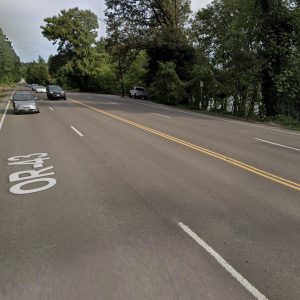Chatter about the Sellwood Bridge is on the upswing. The old bridge, which is failing under its own weight, is set to either be significantly renovated or completely re-constructed. Regional bike planners, advocates, and advisory committee members are getting ready with plans, letters, photographic evidence, informal polls, whatever it takes to ensure that any new construction includes safe and adequate bicycle and pedestrian facilities.
Based on feedback during research for their “Blueprint for Better Biking,” The BTA considers the Sellwood Bridge their #1 priority project at the moment. Money for the bridge was one of the main things the BTA asked for during our time on Capitol Hill and by the responses we got it was clear that our representatives in the Senate and Congress understand that this is a very important project. Here’s a Sellwood Bridge update on the BTA Blog.
Since the bridge is under Multnomah County’s jurisdiction, the Multnomah County Bicycle and Pedestrian Citizen Advisory Committee (MCBPCAC) will have some influence on the final project. I attended their meeting last night and reviewed the letter they will send today (PDF) to Diane Linn and the County Commissioners. Committee member Greg Olson has taken some good photos that illustrate just how terrible conditions are on the existing bridge for bikes and peds. I will try and post those photos soon.
The MCBPCAC is asking for us to send letters to Ms. Linn, telling her how important safe and adequate bike and ped access on the Sellwood Bridge is to the community. You can send letters to:
Chair Diane Linn
Multnomah County Chair’s Office
501 SE Hawthorne Blvd., Suite 600
Portland, OR 97214
For more background information on the Sellwood Bridge, Multnomah County has prepared a good fact sheet. Download the PDF version here. There will also be a new citizens advisory committee forming for this project. If you’d like more information about that, contact Mike Pullen. Stay tuned for more information and developments as this project moves forward.







Thanks for reading.
BikePortland has served this community with independent community journalism since 2005. We rely on subscriptions from readers like you to survive. Your financial support is vital in keeping this valuable resource alive and well.
Please subscribe today to strengthen and expand our work.
I’d encourage folks to attend candidate forums and pressure all the Multnomah and Clackamas County commission candidates on this issue. Even though it’s officially a Multnomah County bridge, five of every six trips across the bridge either start or end outside of Portland, and probably most of those are outside the county, too.
I commute from SE of Milwaukie by bike into the PSU campus, and if the Sellwood were bikeable (safely…) then I would probably use it. As it stands, I use the Hawthorne, which isn’t a bad experience but makes my commute longer.
The other issue is that bike safety on the west side of the bridge isn’t too great, even a bit further north up to 405.
http://www.metro-region.org/article.cfm?articleid=7402
“…make it easier for bikers from Lake Oswego to commute to downtown Portland, because there are better bike routes on the east side of the river.”
U-shaped commutes=poor connectivity
“bike safety on the west side of the bridge isn’t too great” – That’s a serious understatemnt – the communities there are downright bike-hostile (and ped-hostile). Try riding from downtown to the Sellwood bridge on the west side of the river and count the number of signs demanding people to stay on the path. It’s too bad that public river access isn’t mandated the same way beach access is mandated by the state.